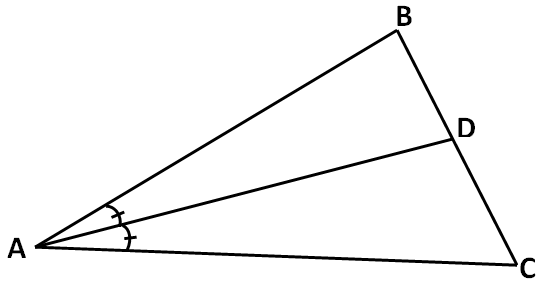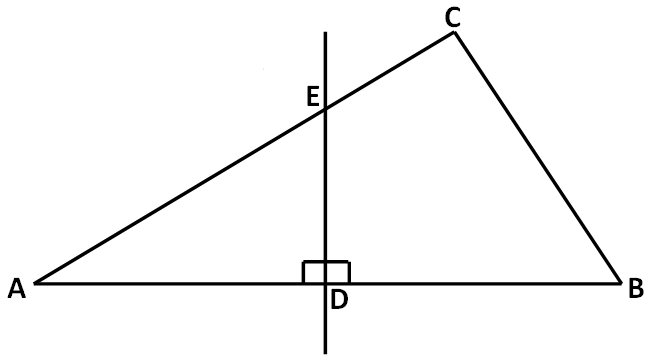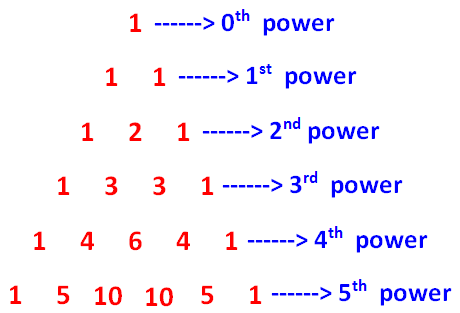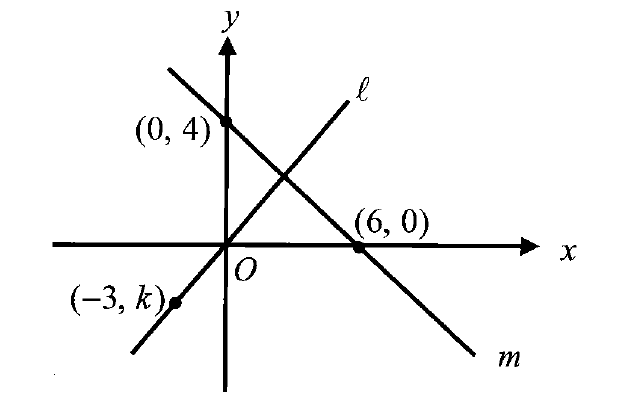SPECIAL LINE SEGMENTS OF TRIANGLES
The following are the four special line segments of a triangle.
1. Angle bisector
2. Perpendicular bisector
3. Median
4. Altitude
Let us see the above four line segments in detail.
Angle Bisector :
The angle bisector divides an angle into two equal parts.

In the above triangle ABC, the line AD bisects the angle A.
That is ∠BAD = ∠DAC.
So, AD is the angle bisector of angle A.
Similarly we can draw angle bisectors to the angles B and C.
Hence, every triangle will have three angle bisectors.
Perpendicular Bisector :
The perpendicular bisector of a triangle is a line which is passing through the mid point of the side and also perpendicular to that side.

In the above triangle, the line ED is passing through the mid point of the side AB and also it is perpendicular to the side AB
So, ED is the perpendicular bisector in the above triangle.
Similarly we can draw perpendicular bisector to the sides BC and AC.
Hence, every triangle will have three perpendicular bisectors.
Median :
The median of a triangle is a line segment joining joining a vertex to the mid point of the opposite side.

In the above triangle, the line segment joining the vertex C and the mid point of AB which is D.
So, CD is the median in the above triangle.
Similarly, we can draw medians from the vertices A and B also.
Hence, every triangle will have three medians.
Altitude (Height) :
Altitude of a triangle is a line segment through a vertex and perpendicular to (That is, forming a right angle with) the opposite side which is considered to be base.

In the above triangle, the line segment AD is passing through the vertex A and perpendicular to the side BC.
So, AD is the altitude of the triangle.
Similarly, we can draw altitudes from the vertices B and C also.
Hence, every triangle will have three altitudes.
Examples
Example 1 :
In the triangle ABC, angle A is divided in to equal halves by the line segment AC. What type of line segment is AC ?
Solution :
Given : Angle A is divided in to equal halves by the line segment AC.
Only the angle bisector will divide an angle in to equal halves.
So, the line segment AC is angle bisector.
Example 2 :
In the triangle ABC, the line segment AD is passing through the vertex A and also perpendicular to the opposite side of the vertex A. What type of line segment is AD ?
Solution :
Given : The line segment AD is passing through the vertex A and also perpendicular to the opposite side of the vertex A.
Only the altitude will pass through the vertex and perpendicular to the opposite side of the vertex.
So, the line segment AD is altitude.
Example 3 :
In the triangle ABC, the line segment ED is not passing through any of the vertex but it is perpendicular to one of the sides of the triangle and also passing through the mid point of the same side. What type of line segment is ED ?
Solution :
Given : The line segment ED is not passing through any of the vertex but it is perpendicular to one of the sides of the triangle and also passing through the mid point of the same side
Since the line segment ED is not passing through any of the vertex, it can not be altitude.
But ED is perpendicular to one of the sides of the triangle and also it is passing through the midpoint of the same side.
So, the line segment ED is perpendicular bisector.
Example 4 :
In the triangle ABC, the line segment AD is passing through the vertex A, perpendicular to the side BC and also passing through the mid point of the side BC. What type of line segment is AD ?
Solution :
Given : The line segment AD is passing through the vertex A, perpendicular to the side BC and also passing through the mid point of the side BC
Since the line segment AD is passing through one of the vertices vertex and perpendicular to the side BC, clearly AD is altitude.
But AD is also passing through the midpoint of BC. So it is also perpendicular bisector and median.
So, the line segment AD is altitude, perpendicular bisector and median.
Example 5 :
In the triangle ABC, the line segment AD joining the vertex A and the midpoint of the side BC. What type of line segment is AD ?
Solution :
Given : The line segment AD joining the vertex A and the midpoint of the side BC.
Only the median will join one of the vertices of the triangle and the mid point of the opposite side of the vertex.
So, the line segment AD is median.
Example 6 :
In the triangle ABC, there is a angle bisector at angle A. After the angle A is divided in to two equal halves, if each half measures 22°, find angle A.
Solution :
Given : Angle A is divided in to two equal halves by the angle bisector and each half measures 22°,
Angle A = 22° + 22°
Angle A = 44°
Example 7 :
In the triangle given below, AD is the angle bisector. If ∠B = 70° and ∠C = 60°, find ∠BAD and ∠DAC.

Solution :
The angle sum property of a triangle states that the angles of a triangle always add up to 180°.
Then,
∠A + ∠B + ∠C = 180°
∠A + 70° + 60° = 180°
∠A + 130° = 180°
∠A = 50°
Because AD is the angle bisector, it divides the angle ∠A into two equal halves. That is 25° and 25°
So,
∠BAD = 25°
∠DAC = 25°
Example 8 :
In the triangle given below, ED is the perpendicular bisector. If ∠B = 60° and ∠C = 70°, find angle ∠AED.

Solution :
The angle sum property of a triangle states that the angles of a triangle always add up to 180°.
∠A + ∠B + ∠C = 180°
∠A + 60 + 70 = 180
∠A + 130 = 180
∠A = 50°
In triangle AED, we have
∠A + ∠AED + ∠EDA = 180°
50 + ∠AED + 90 = 180
∠AED + 140 = 180
∠AED = 40°
Example 9 :
In the triangle given below, CD is the median. If ∠B = 60° and ∠ADC = 120°, find ∠BCD.

Solution :
Given : ∠ADC = 120°
From the given figure, angle ADC and angle CDB together form a straight angle.
Then,
∠ADC + ∠CDB = 180°
120° + ∠CDB = 180°
∠CDB = 60°
In triangle BCD, we have
∠B + ∠BCD + ∠CDB = 180°
60° + ∠BCD + 60° = 180°
∠BCD + 120° = 180°
∠BCD = 60°
Example 10 :
In the triangle given below, AD = 4 cm and BC = 8 cm, find the area of the triangle.

Solution :
In the given figure, clearly AD is the height (altitude) and BC is the base of the triangle.
Area of the triangle = (1/2) ⋅ b ⋅ h
= (1/2) ⋅ 8 ⋅ 4
= 16 square cm.
So, the area of the triangle is 16 square cm.
Kindly mail your feedback to v4formath@gmail.com
We always appreciate your feedback.
©All rights reserved. onlinemath4all.com
Recent Articles
-
Pascal Triangle and Binomial Expansion
Feb 01, 25 10:12 AM
Pascal Triangle and Binomial Expansion - Concept - Examples -
SAT Math Resources (Videos, Concepts, Worksheets and More)
Feb 01, 25 06:26 AM
SAT Math Resources (Videos, Concepts, Worksheets and More) -
Digital SAT Math Problems and Solutions (Part - 106)
Feb 01, 25 06:23 AM
Digital SAT Math Problems and Solutions (Part - 106)

